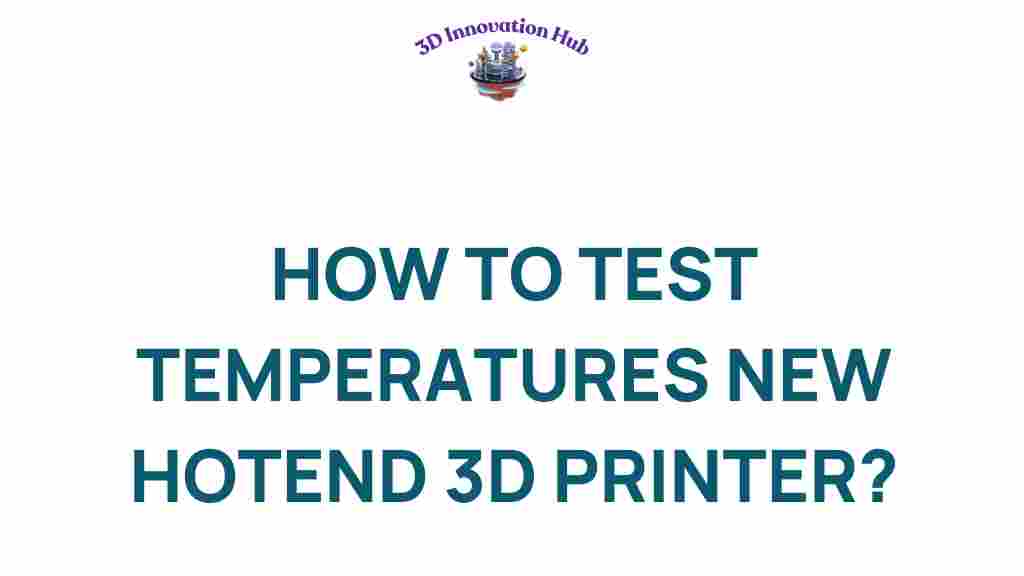3D Printing: Testing Temperatures in Your Hotend
In the world of 3D printing, precision is key to achieving high-quality prints. One of the critical components that influence the success of your prints is the hotend. The temperature testing of your hotend can significantly affect the performance of your printer and the quality of the finished product. In this article, we will guide you through the process of testing temperatures in your 3D printer’s hotend, explore the importance of calibration, and provide troubleshooting tips to enhance your DIY 3D printing experience.
Why Is Temperature Testing Important?
Every filament used in 3D printing has a specific temperature range it operates best within. If the hotend does not reach the correct temperature, it can lead to various issues such as:
- Poor layer adhesion
- Stringing and oozing
- Clogs in the hotend
- Inconsistent extrusion
- Overall print failure
By performing regular temperature testing and calibration, you can ensure that your printer operates at peak performance, resulting in high-quality prints every time.
Tools You Will Need for Temperature Testing
Before diving into the temperature testing process, gather the following tools:
- Thermocouple or an infrared thermometer
- Digital multimeter (optional, for advanced users)
- Filament sample (PLA, ABS, PETG, etc.)
- 3D printer with a hotend
- Computer with slicer software
Step-by-Step Process for Temperature Testing Your Hotend
Now, let’s break down the steps for testing the temperature of your hotend:
Step 1: Prepare Your Printer
Begin by ensuring your 3D printer is set up correctly. Check that all components are securely attached, and the printer is connected to your computer.
Step 2: Load Your Filament
Choose the filament you want to test. For this example, we will use PLA. Load the filament into the hotend according to your printer’s instructions.
Step 3: Preheat the Hotend
Using your printer’s interface or slicer software, preheat the hotend to the recommended temperature for the filament. For PLA, this is typically around 200°C. Make sure to monitor the temperature closely.
Step 4: Measure the Actual Temperature
Once the hotend reaches the set temperature, use your thermocouple or infrared thermometer to measure the actual temperature of the hotend. It’s crucial to check this while the filament is being extruded.
Step 5: Compare and Record Results
Compare the measured temperature with the expected temperature for the filament. Record your findings, noting any discrepancies. This information is vital for future calibration efforts.
Step 6: Adjust Temperature Settings
If you find that the actual temperature is significantly different from the set temperature, you may need to adjust the temperature settings in your slicer software. For example:
- If the temperature is too low, increase it by 5-10°C.
- If it’s too high, reduce it by the same amount.
Step 7: Test Again
Repeat the heating and measuring process after making adjustments. Continue this until the hotend temperature matches the desired setting closely.
Troubleshooting Temperature Issues
Even with careful temperature testing, issues can arise. Here are some common problems and solutions:
Inconsistent Temperature Readings
If your temperature readings fluctuate, consider the following:
- Check the thermocouple connection; it may be loose or damaged.
- Ensure your measuring device is calibrated correctly.
- Look for draft or airflow that could be affecting the readings.
Filament Not Extruding Properly
If your filament isn’t extruding properly even after testing:
- Verify that the hotend is clean and free of clogs.
- Check that the filament is loaded correctly and not tangled.
- Make sure the extruder is functioning correctly.
Hotend Overheating
If you notice your hotend is overheating:
- Inspect the cooling fan to ensure it’s operational.
- Check for any signs of heat creep in the heat break.
- Consider reducing the set temperature for the filament.
Final Thoughts on Precision in 3D Printing
Temperature testing is a vital aspect of 3D printing that can greatly influence the quality of your prints. By taking the time to perform detailed calibration, you can ensure that your hotend operates within the appropriate temperature range for your chosen filament. This diligence will help you avoid common pitfalls and enhance your overall 3D printing experience.
As technology continues to evolve, staying informed about best practices in DIY 3D printing and understanding your equipment will keep you ahead of the game. For more tips and techniques on 3D printing, visit this resource.
In conclusion, mastering the art of temperature testing not only improves your printing quality but also enhances your knowledge and skills as a 3D printing enthusiast. So grab your tools, test your temperatures, and unleash the precision that your 3D printer is capable of achieving!
This article is in the category and created by 3D Innovation Hub Team
